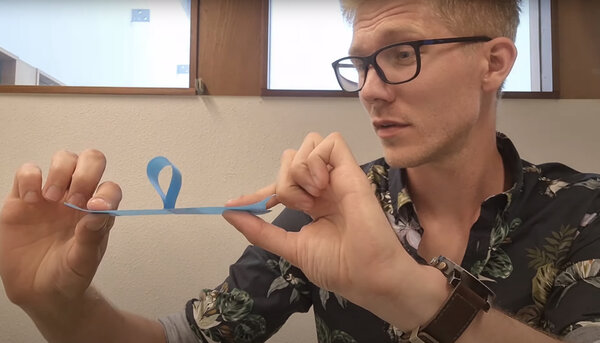How to unloop a sticky loop
It’s the end of the road for annoying loops and blisters in adhesives as our researchers help develop a model that shows how best to remove them.

Besides being sticky, what do band aids and adhesive tapes have in common? Blisters and loops of course! Surely, you’ve encountered blisters (tiny air pockets) or loops when using band aids or tapes, which can be quite annoying and difficult to remove. What’s more, they can also affect the materials used to make flexible electronics and soft robotics. Fear not though as researchers from Eindhoven University of Technology and University of Twente have studied the unpeeling of looped adhesive tape and developed a new model to explain how best to remove troublesome loops. The new research is published in European Physics Letters.

Imagine a tape where the two sticky sides are stuck together resulting in a loop. If you try to remove the loop by pulling the two loop ends, something surprising happens.
The size of the contact area between the sticky sides starts to decrease but the loop doesn’t then unloop as you might expect. Instead, as you peel the two sides apart, the loop just shrinks in size until it reaches a critical small size and then eventually unloops.
This startling behavior perplexed Twan Wilting, PhD candidate in the Fluids and Flows group in department of Applied Physics at TU/e working with Hanneke Gelderblom, for quite some time. “I came across this effect a few years ago and couldn’t find a solution online. I even reached out to YouTubers for a solution, but to no avail.”
Then in 2019, Wilting attended a course by Jacco Snoeijer (Faculty of Science and Technology, University of Twente) in which Snoeijer discussed adhesives and spoke about the YouTube videos that Wilting was overly familiar with. “I was approached by Twan with the problem afterwards, and he asked me if I would be interested in working with him on it,” says Snoeijer. “We agreed to collaborate, and things moved quickly after that.”
Experimental challenges
Removing loops and blisters has implications for more than just band aids and sticky tape, as Jacco Snoeijer points out. “When working with materials for thin flexible electronics and soft robotics, it’s important to know what forces should be applied to remove blisters or loops. Otherwise, you face the prospect of permanently damaging the material."
To study how loops change when subject to varying peeling forces and velocities, the researchers decided to study how loops evolved in different tapes. But they needed a reliable way to make straight tape loops in the lab.
“In straight tape loops the two sticky sides of the tape are perfectly aligned or parallel. If the two sides were not parallel, the loop would twist as the size decreased, and we wanted to avoid any twisting physics,” notes Wilting. “As we didn’t have automated devices, we had to make the loops by hand. It goes without saying that it was a testing and trying process!”
Model breakthrough for real-world loops
Once the unpeeling experiments had been complete, the researchers used the observations to construct a new model that describes the loop shrinkage process and gives an indication of the critical loop size (before final unlooping) and the critical peeling force.
“The model matches the experimental observations very well. Perhaps in the future we’ll add more to the model, particularly on how the adhesives evolve during unlooping,“ says Snoeijer.
It’s one thing to remove loops in specially prepared tapes, but it’s another thing to remove loops in practical settings. Wilting and the researchers know there are plenty of applications for their model in the real-world: “Blisters and loops occur in multi-layered coatings, flexible electronics, soft robotics, even during the production of graphene (the material made of carbon atoms in a honeycomb lattice that is one carbon atom thick). This means you need to know what happens during folding and self-adhesion processes, and that’s where our model can certainly help.”
Serendipity and science communication
Finally, there’s significant serendipity about this research study. Sitting beside Wilting during that course given by Jacco Snoeijer in 2019 was Martin Essink, a PhD candidate working with Snoeijer who encouraged Wilting to approach Snoeijer about the puzzle. Added to that, Snoeijer was the supervisor of Hanneke Gelderblom, Wilting’s supervisor at TU/e. All four are authors on this new paper. It seemed inevitable then that they would get stuck together on this project!
And to further promote this work, Wilting has produced a one-minute video for the Veritasium Contest, a science communication competition contest run by the YouTube channel of the same name.
So, loops that form in adhesive tape, flexible electronics, and graphene flakes had better watch out. Their future is about to constructively unravel.
Full paper details
“How to unloop a self-adherent sheet”, Twan Wilting, Martin Essink, Hanneke Gelderblom, and Jacco Snoeijer, European Physics Letters, (2021).
Media contact
Latest news



